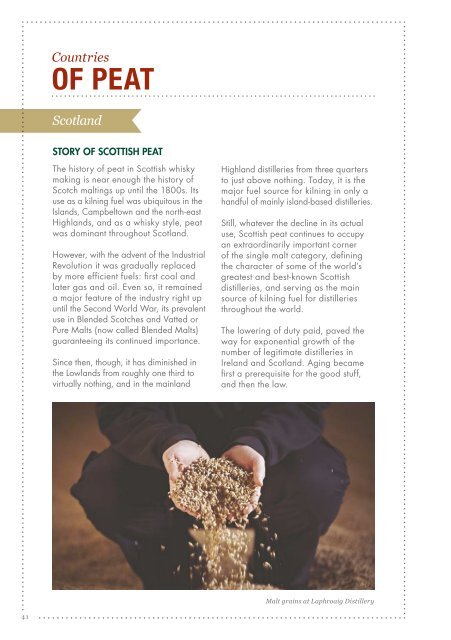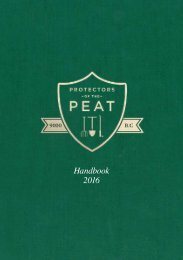POTP_J747_US_Handbook_A5_Digital_AW-2
You also want an ePaper? Increase the reach of your titles
YUMPU automatically turns print PDFs into web optimized ePapers that Google loves.
Countries<br />
OF PEAT<br />
TYPES OF SCOTTISH PEAT<br />
Today, the peat used in Scotch whiskies is largely found in Islay, the north-east<br />
Highlands and Orkney. Given these areas’ differing bioclimatic histories, the flavor<br />
enhancing characteristics of their particular peats are perceptively different:<br />
Scotland<br />
STORY OF SCOTTISH PEAT<br />
The history of peat in Scottish whisky<br />
making is near enough the history of<br />
Scotch maltings up until the 1800s. Its<br />
use as a kilning fuel was ubiquitous in the<br />
Islands, Campbeltown and the north-east<br />
Highlands, and as a whisky style, peat<br />
was dominant throughout Scotland.<br />
However, with the advent of the Industrial<br />
Revolution it was gradually replaced<br />
by more efficient fuels: first coal and<br />
later gas and oil. Even so, it remained<br />
a major feature of the industry right up<br />
until the Second World War, its prevalent<br />
use in Blended Scotches and Vatted or<br />
Pure Malts (now called Blended Malts)<br />
guaranteeing its continued importance.<br />
Since then, though, it has diminished in<br />
the Lowlands from roughly one third to<br />
virtually nothing, and in the mainland<br />
Highland distilleries from three quarters<br />
to just above nothing. Today, it is the<br />
major fuel source for kilning in only a<br />
handful of mainly island-based distilleries.<br />
Still, whatever the decline in its actual<br />
use, Scottish peat continues to occupy<br />
an extraordinarily important corner<br />
of the single malt category, defining<br />
the character of some of the world’s<br />
greatest and best-known Scottish<br />
distilleries, and serving as the main<br />
source of kilning fuel for distilleries<br />
throughout the world.<br />
The lowering of duty paid, paved the<br />
way for exponential growth of the<br />
number of legitimate distilleries in<br />
Ireland and Scotland. Aging became<br />
first a prerequisite for the good stuff,<br />
and then the law.<br />
ORKNEY<br />
The peat on Orkney falls between the<br />
two, and depending on the depth of<br />
extraction, generally results in a more<br />
floral-like smoky flavor.<br />
HIGHLANDS<br />
In the mainland Highlands, the greater<br />
ratio of wood to peat moss makes for<br />
bonfire-like smoky flavors.<br />
ISLAY<br />
Composed of a ratio of less wood<br />
to peat moss, Islay has a higher<br />
phenol count, and is therefore more<br />
medicinal in flavor.<br />
Malt grains at Laphroaig Distillery<br />
41<br />
42



